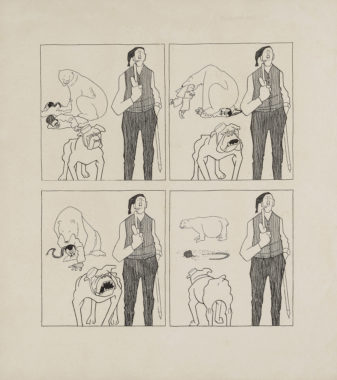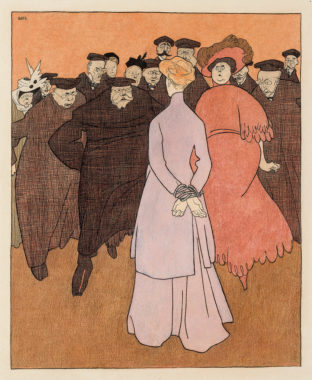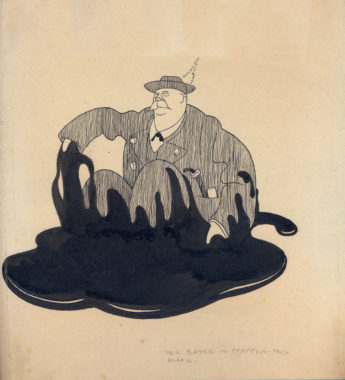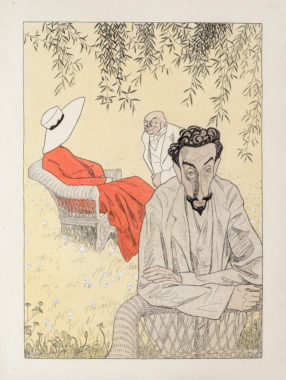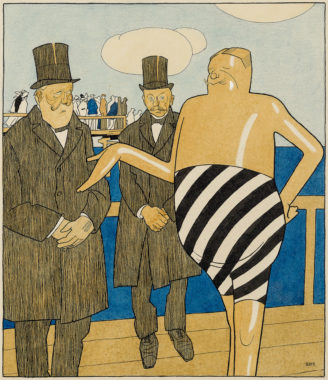Gulbransson, Olaf
Available Artworks
Sold Artworks
Biography
Olaf Gulbransson
1873 Oslo – 1958 Tegernsee (Bavaria)
At a very early age, Olaf Gulbransson already displayed outstanding drawing skills. It was therefore no surprise that at the age of twelve he should be admitted to the Royal School of Arts and Crafts in Oslo. He began producing caricatures for Norwegian satirical magazines as a student and earned widespread recognition for his work through exhibitions at home and abroad. In 1902, he met the Munich publisher Albert Langen, who offered him a job on the permanent staff of the weekly satirical magazine Simplicissimus he had founded in 1896. Gulbransson moved to Munich and between 1903 and 1944 was to be one of the magazine’s most popular caricaturists. Highly acclaimed and widely liked, he was noted for his eskimoesque appearance and a passion for nudism.
Gulbransson shot to fame and popularity among Simplicissimus readers with a series of portraits titled Berühmte Zeitgenossen [Famous Contemporaries]. This 59-part series was published in irregular intervals from 1903 onwards. The portraits testify to his extraordinary ability to accurately portray human gestures and facial expressions using as his models prominent figures from the world of art, literature, music and intellectual life such as Franz von Lenbach, Gerhart Hauptmann, Siegfried Wagner and Theodor Mommsen. The portraits, executed in pen and ink, display a soft, smooth, highly precise linearity that dispenses with any excessive distortions and provides a humorous glimpse of the character and self-image of the figures portrayed. His caricatures on current political and ethical issues, many of them published as full-page illustrations in Simplicissimus, enjoyed equal popularity with the magazine’s readership. Despite a critical stance, he generally adopted a healthy level of detachment, balancing opposites and thereby striking a more conciliatory tone than, for example, Thomas Theodor Heine, who had a reputation for caustic sarcasm. Gulbransson’s distinctive graphic imagery is highly reduced in its linearity and marked by unconventional viewpoints and the use of extreme elongation and reduction. Often, the viewer himself is required to add elements that are missing. Many of Gulbransson’s caricatures were developed at the suggestion of a close friend, the writer Ludwig Thoma, who was also a Simplicissimus contributor. Thoma would provide the punch line for the caption and they would also work together on strip cartoons – for example Ein Münchner im Himmel – and Bavarian classics such as the book Lausbubengeschichten.
In World War I Gulbransson was called to Berlin as a propaganda artist for the German Foreign Ministry. He met and befriended Max Liebermann, who introduced him to painting with oils. During the Weimar Republic Gulbransson spent many years back in his native Norway. He was not to return to Bavaria until 1929 when he was offered a professorship at the Munich Academy of Art as successor to Franz von Stuck. He purchased a property known as the ‘Schererhof’ near the Tegernsee and settled permanently in Bavaria. He offered a first review of his life in an autobiography published in 1934 titled Es war einmal. A second volume titled Und so weiter followed in 1954. In 1966, the Olaf Gulbransson Museum was founded in Tegernsee to safeguard his memory and nurture awareness of his artistic legacy.
PDF Download
